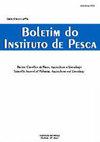Digestible protein levels and metabolic responses in juvenile piapara (Megaleporinus obtusidens)
IF 0.6
4区 农林科学
Q4 FISHERIES
引用次数: 0
Abstract
The piapara (Megaleporinus obtusidens) is an omnivorous fish with great market potential. However, little is known about its dietary requirements. This study aimed to determine the effects of dietary protein on growth and physiological indicators in piapara. Three hundred piapara juveniles (24.0 ± 1.3 g) were distributed in 20 tanks of 130-L (15 fish/tank) provided with continuous aeration and water. Five isoenergetic diets (14.0 MJ/kg) were formulated to contain increasing levels of digestible protein (21, 24, 27, 30, and 33% DP). After 77 days, weight gain and ammonia concentration in water were found to increase linearly with increasing digestible protein (DP) level (p<0.05). Protein productive value (PPV) reached a maximum at 28.4% DP. No relationship was found between DP level and serum ammonia, liver alanine aminotransferase (ALT) activity, hepatosomatic index (HSI), liver glycogen (GL) or liver lipid (LL) content (p>0.05). Mesenteric fat index (MFI) and liver malic enzyme (ME) activity followed a quadratic pattern (p<0.05) and reached a maximum at 25.8% and 27.1% DP, respectively. Muscle lipid (ML) content decreased linearly with increasing DP level (p<0.05), whereas liver glucose-6-phosphate dehydrogenase (G6PD) activity decreased linearly as DP level increased (p<0.05). Results showed that a diet containing 28.4% PD provides better crude protein retention efficiency and reduces amino acid deamination in M. obtusidens. Low protein diets increased energy retention efficiency, whereas fish fed high protein diets had higher ammonia excretion.黑斑蝶幼鱼可消化蛋白水平及代谢反应
圆齿鱼(Megaleporinus obtusidens)是一种市场潜力巨大的杂食性鱼类。然而,人们对其饮食需求知之甚少。本试验旨在研究饲粮中蛋白质对虾蛄生长及生理指标的影响。在20个130-L(15尾/箱)的连续曝气和水池中,分配300尾幼鱼(24.0±1.3 g)。配制5种等能饲粮(14.0 MJ/kg),提高可消化蛋白质水平(21%、24%、27%、30%和33% DP)。77 d后,随着可消化蛋白质(DP)水平的升高,增重和水中氨浓度呈线性增加(p0.05)。肠系膜脂肪指数(MFI)和肝脏苹果酸酶(ME)活性呈二次曲线(p<0.05),分别在25.8%和27.1% DP时达到最大值。肌脂(ML)含量随DP水平的升高而线性降低(p<0.05),肝脏葡萄糖-6-磷酸脱氢酶(G6PD)活性随DP水平的升高而线性降低(p<0.05)。结果表明,饲粮中PD含量为28.4%时,粗蛋白质保留率较高,氨基酸脱胺率较低。低蛋白质饲料提高了能量保留效率,而高蛋白饲料提高了氨排泄量。
本文章由计算机程序翻译,如有差异,请以英文原文为准。
求助全文
约1分钟内获得全文
求助全文
来源期刊

Boletim do Instituto de Pesca
FISHERIES-ZOOLOGY
CiteScore
0.80
自引率
0.00%
发文量
24
审稿时长
>12 weeks
期刊介绍:
To publish original articles of research and short communications in the following áreas: Fisheries, Aquaculture, Zootechnology, Limnology, Oceanography, Biology and Pathology of aquatic organisms. The publication depends on the approval of the Editorial Board, based on the peer review.
 求助内容:
求助内容: 应助结果提醒方式:
应助结果提醒方式:


